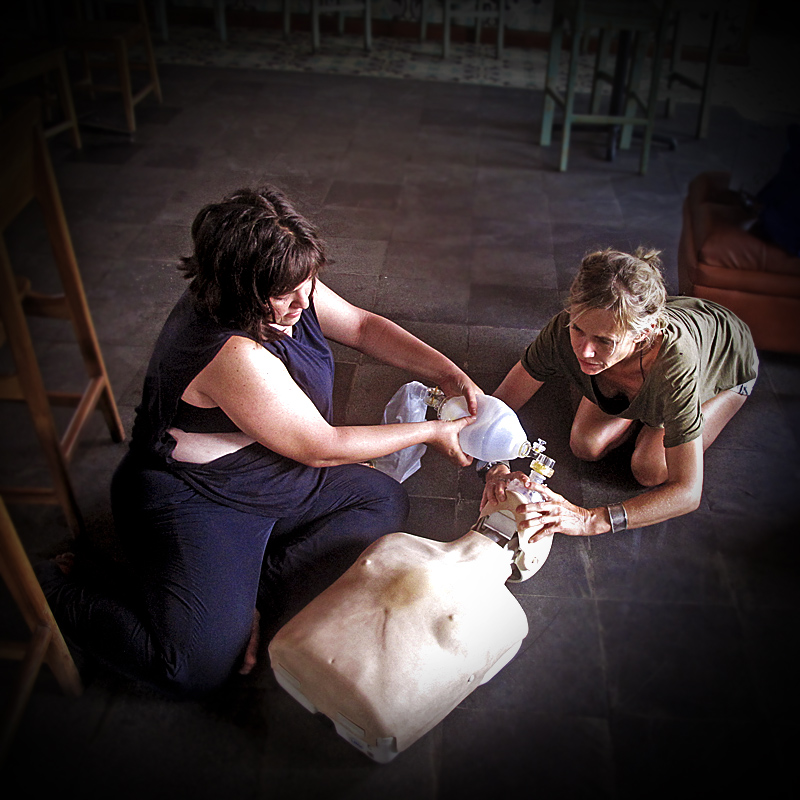First Aid is a very useful course for any diver and is actually a required prerequisite before certifying as a PADI Rescue Diver, Divemaster and Instructor candidate. Although PADI provide a syllabus for instructors to teach others the basics, there is no reason why an instructor shouldn’t put more advanced skills into their training.
What’s included in the Basic EFR and EFRI Program
The PADI Emergency First Response Instructor (EFRI) provides scuba instructor candidates with a range of additional rescue diver skills outside of the PADI based curriculum. The basic PADI EFR program aims to address the very basics of Primary Care (CPR), Secondary Care (First Aid), Care for Children, Administering CPR & using an AED and First Aid at Work
Emergency First Response Primary Care (CPR) teaches participants how to respond to life-threatening emergencies. The course focuses on primary care through a combination of knowledge development, skill development and realistic scenario practice to make sure participants have the confidence in their ability to provide care when emergency situations arise.
Primary Care (CPR) skills taught in this course include Scene Assessment, Barrier Use, Primary Assessment, Cardiopulmonary Resuscitation (CPR), Serious Bleeding Management, Shock Management, Spinal Injury Management, Conscious and Unconscious Choking Management as well as the use of an Automated External Defibrillator (AED) and Emergency Oxygen.
What additional components does Holly Macleod Include
Industry Leading Platinum PADI Course Director Holly Macleod has a wealth of direct experience as a PADI Scuba Diving Instructor spanning over 17 years and as an EFR Instructor, a Diving Emergency Medical Responder (DEMR) and a DAN Dive Medic she has incorporated a range of additional components into the standard EFRI program offered alongside the PADI Scuba Diving Instructor Development Course (IDC).
In addition to the standard EFRI course curriculum, Platinum PADI Course Director Holly Macleod includes a number of additional components such as tourniquet use for cases of serious bleeding, the use of adjuncts in Airway Management, additional techniques to respond more effectively to drowning incidents and advanced resuscitation methods using a bag valve mask (BVM)/ resuscitator/ self-inflating bag or sometimes known by the proprietary name Ambu bag. Although there are many things that could be included within the PADI EFR/ EFRI course, it still needs to be kept simple, easy to understand and easy to deliver.
Airway Management & Obstructions
Airway control is a vital part of EFR and to take this one stage further, candidates on an EFRI program with Holly Macleod will look further into the aspects of dealing with airway obstructions and the use of adjuncts in Airway Management.
Obstructions often take place in the oropharynx, whereby the tongue and Jaw muscles move cause the tongue and epiglottis to cause an obstruction. Within unconscious patients a low central drive can reduce the activity of the pharyngeal dilator muscles and therefore result in a collapse of the upper airway.
So in these circumstances within a diving rescue scenario with an unconscious diver, the head tilt-chin lift manoeuvre could prove to be ineffective in providing ventilation. This is when an OPA would be needed.
An oropharyngeal airway (oral airway, OPA) is an airway adjunct used to maintain or open the airway by stopping the tongue from covering the epiglottis. In this position, the tongue may prevent an individual from breathing. During the PADI Emergency First Response Instructor Course PADI Course Director introduces candidates to methods of using Airway Adjuncts.


Manual resuscitator /self-inflating bag
Another additional component introduced during the PADI Emergency First Response Instructor Course is the exploration of resuscitation methods using a bag valve mask (BVM)/ resuscitator/ self-inflating bag or sometimes known by the proprietary name Ambu bag.
A bag valve mask (BVM) should be used when the patient needs to be transported further distances. Using the Ambu bag should only be attempted by those who have been trained to use it and although it looks simple users need to be aware of how to make sure the patient is getting enough oxygen when it is being used
When using the device, the mask needs to be pressed over the mouth of the victim and using the bag the rescuer forces air into the victim’s lungs. The bag than returns to its original form so that continuous ventilations can be administered. The bag then refills itself with air when released, allowing it to return to its original shape. The bag can be squeezed out and re-inflated rapidly and repeatedly to resuscitate the patient using supplemental Oxygen, even if the patient can’t breathe on their own.
The resuscitator/ self-inflating bag or Ambu bag is inexpensive and does not take up much room and is therefore the perfect addition to any diver’s first aid kit, however the user does need to be trained in how to use it properly.
Purpose-made tourniquet
A tourniquet is a device used to stop blood flow to the limb. It can be purpose built or improvised. Blood flow to the limb is achieved by securing and tightening a band around the limb to arrest blood flow.
Many instructors will teach the rope and stick method of implementing a tourniquet which is great as a basic improvised way to deal with serious bleeding. However existing guidelines call for the use of improvised “rope-and-stick” tourniquets as a last resort to stop severe bleeding and purpose made designs can now provide greatly increased safety and efficiency.
On the PADI Emergency First Response Instructor Course with Holly Macleod participants are introduced to the use of purpose made tourniquets which are inexpensive and do not take up much room and therefore a great piece of equipment for any rescue diver to purchase.

The PADI Instructor Development Course (IDC)
The PADI Emergency First Response Instructor Course comes as part of the PADI Instructor Development Course with takes place at the only 5 Star PADI IDC Career Development Centre (CDC) to have ever been established on the Island of Gili Trawangan.
The program is entirely conducted by Award winning, Industry Leading Multiple Platinum PADI Course Director Holly Macleod who has a wealth of Industry experience spanning over 17 years working in a variety of global diving destinations including Honduras, Thailand, Australia, UK, Malaysia, Philippines, Indonesia, Singapore. Having issued well over 3000 Instructor level certifications and been awarded the Platinum and Elite Instructor status for the past 7 years consecutively, Holly has designed her programs to provide a standard of training now considered to be well over and above that generally found within industry.
Other benefits of taking Instructor training on the PADI IDC Indonesia with Holly Macleod include online preparation tools with the Gili IDC Online Platform and huge reputation amoungst the dive community within South East Asia. For more information check out the PADI IDC Reviews or contact Holly directly on




